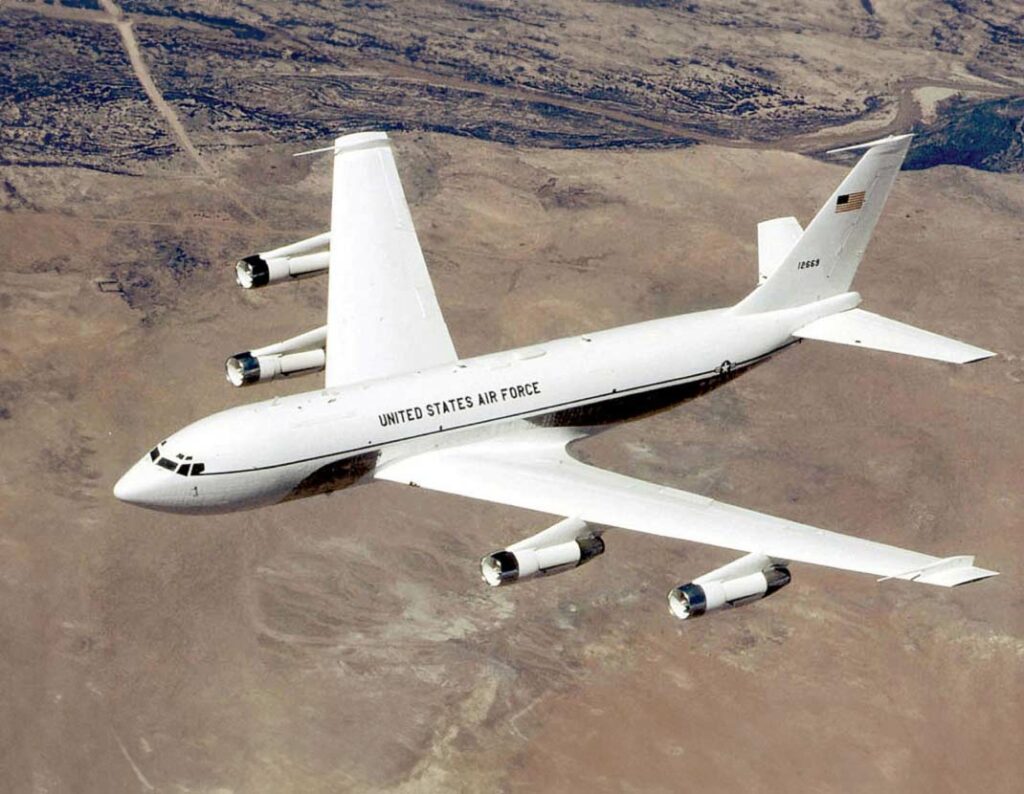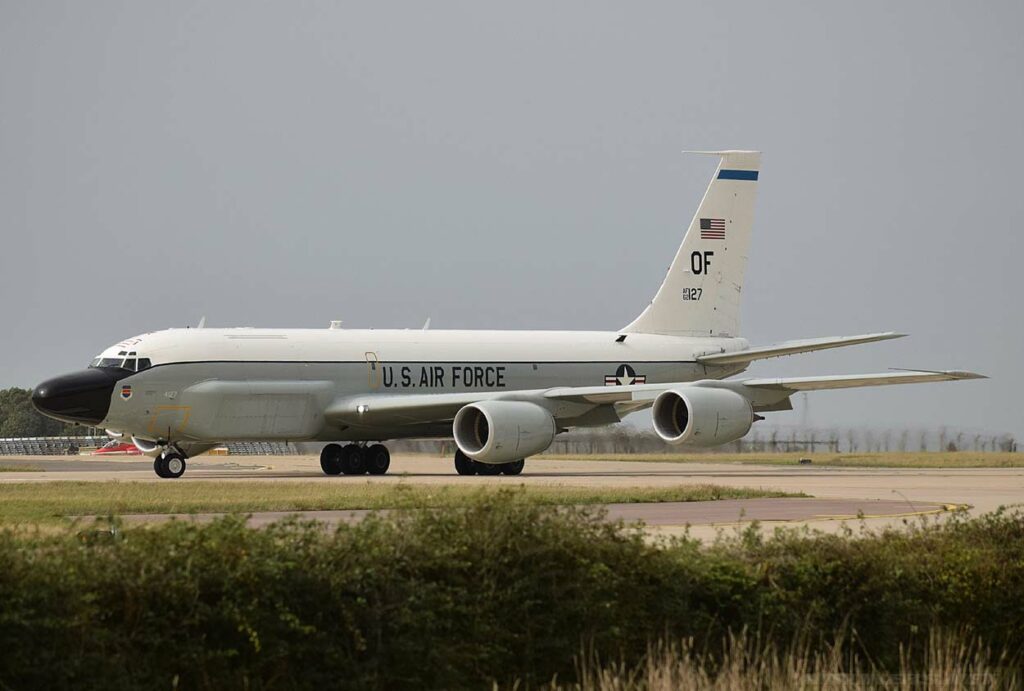A pivotal mid-air refueling and transport aircraft, the C-135 served as the backbone of USAF strategic operations.
Technical Summary
The Boeing C-135 Stratolifter is a military air refueling tanker and transport aircraft developed by Boeing in the mid-1950s. Based on the Boeing 367-80 prototype, it was designed to meet the United States Air Force’s (USAF) requirements for a jet-powered tanker to support its strategic bomber fleet. The C-135 series includes several variants, primarily serving as aerial refueling tankers, but also configured for electronic reconnaissance, command and control, and VIP transport roles. It has a crew capacity that varies by mission but typically includes pilots, navigators, and boom operators. The aircraft features four turbofan engines, enabling it to reach a maximum speed of 610 mph (982 km/h) and a range of over 4,000 miles (6,437 km) with in-flight refueling capabilities. Its design laid the groundwork for the later KC-135 Stratotanker and introduced jet propulsion to air refueling operations, significantly enhancing the USAF’s global reach and operational flexibility.
The Boeing C-135 Stratolifter, developed by Boeing in the 1950s, marked a significant advancement in military aviation, primarily serving the United States Air Force (USAF) for mid-air refueling and strategic transport roles. This aircraft emerged from the need for a more capable, jet-powered air refueling platform to extend the operational range of the USAF’s bomber and fighter aircraft during the Cold War era.

History of the Development of the Boeing C-135 Stratolifter
In the context of the Cold War, the need for a robust and reliable air refueling capability became paramount for the United States. The strategic doctrine of the time emphasized the ability to project air power globally, which required long-range bombers and fighters to be refueled in mid-air to reach distant targets. Recognizing this need, the USAF initiated a program to develop a jet-powered tanker aircraft that would replace the older, propeller-driven tankers.
Boeing, leveraging its experience with the Boeing 367-80 (also known as the “Dash-80”) prototype, proposed a design that would meet the USAF’s requirements. The program was officially launched in the mid-1950s, and the Boeing C-135 Stratolifter first flew on August 17, 1956. This marked the beginning of a new era in air refueling and strategic mobility for the USAF and its allies.
The development of the C-135 was driven by the strategic imperatives of the Cold War, where the USA and the Soviet Union were in a constant state of military readiness. The C-135 Stratolifter was designed to enhance the USAF’s capability to conduct long-range bombing missions, provide global air mobility, and support airborne command and control operations.
While the C-135 did not receive a specific NATO nickname, its variants, including the well-known KC-135 Stratotanker, became integral to NATO’s air operations, providing critical refueling support that extended the reach of NATO air forces.
The C-135 Stratolifter’s development was not just a response to strategic military needs but also a reflection of the technological advancements of the era. It demonstrated the transition from propeller-driven aircraft to jet-powered engines, setting new standards for speed, range, and efficiency in military aviation.
Design of the Boeing C-135 Stratolifter
The Boeing C-135 Stratolifter’s design was characterized by its sleek, aerodynamic profile, incorporating four turbofan engines that offered significant improvements in speed and range over the propeller-driven tankers it was designed to replace. The aircraft’s dimensions included a wingspan of 130 feet (39.62 meters) and a length of 136 feet (41.45 meters), with a maximum takeoff weight of approximately 300,000 pounds (136,077 kilograms).
One of the major advantages of the C-135’s design was its versatility. The basic airframe was adaptable to a wide range of missions, from aerial refueling to electronic surveillance and command and control. This adaptability allowed the USAF to utilize the C-135 platform across various roles, maximizing its investment in the aircraft.
However, the C-135 also had its drawbacks. The reliance on specific runway lengths and infrastructure requirements limited its operational flexibility in some scenarios. Additionally, as newer technologies and aircraft designs emerged, some aspects of the C-135’s capabilities were surpassed by later models, leading to incremental upgrades and the development of variants to maintain its operational relevance.
The design of the C-135 Stratolifter brought significant advancements to military aviation. Its introduction of jet-powered air refueling operations revolutionized the USAF’s strategic capabilities, enabling longer, faster, and more efficient missions. The aircraft’s development underscored the importance of adaptability and innovation in responding to changing military requirements and technological landscapes.
Performance of the Boeing C-135 Stratolifter
The performance of the Boeing C-135 Stratolifter was a key factor in its success and longevity as a military asset. Equipped with four Pratt & Whitney TF33 turbofan engines, each producing up to 18,000 pounds of thrust, the C-135 offered a top speed of approximately 610 mph (982 km/h) and a cruising speed of 500 mph (805 km/h). Its service ceiling reached up to 50,000 feet (15,240 meters), with a range of over 4,000 miles (6,437 km) without in-flight refueling. These performance characteristics enabled the C-135 to fulfill a wide range of missions, from rapid strategic transport to extended aerial refueling operations.
When compared to its contemporaries, the C-135 demonstrated a superior combination of speed, range, and payload capacity. Its jet-powered engines provided a significant advantage over older, propeller-driven tanker aircraft, such as the KC-97 Stratofreighter, enabling the C-135 to operate more effectively with the jet-powered bombers and fighters of the era. This capability was crucial in maintaining the USAF’s global reach and operational flexibility during the Cold War.
The C-135’s performance also facilitated its adaptation into various specialized roles. Its high service ceiling and speed made it an ideal platform for electronic reconnaissance and command and control missions, where staying aloft for extended periods and covering vast areas quickly were essential.
Variants of the Boeing C-135 Stratolifter
The Boeing C-135 Stratolifter family includes several variants, each designed to fulfill specific mission requirements. The most well-known variant is the KC-135 Stratotanker, which serves as the primary aerial refueling aircraft for the USAF. Other notable variants include the EC-135, used for airborne command, control, and communications; the RC-135, configured for reconnaissance and surveillance; and the WC-135, known as the “Weather Bird,” used for atmospheric sampling and weather reconnaissance.
Each variant of the C-135 was modified to optimize its performance for the intended role. For example, the KC-135 Stratotanker featured a refueling boom and additional fuel tanks to maximize its effectiveness as a tanker. The EC-135 included advanced communication and control systems, enabling it to serve as an airborne command post. The differences among the variants highlight the C-135 platform’s adaptability and versatility, allowing it to serve a wide range of operational needs.

Military Use and Combat of the Boeing C-135 Stratolifter
The Boeing C-135 Stratolifter and its variants have played a crucial role in numerous military operations and conflicts since their introduction. As an aerial refueling tanker, the KC-135 Stratotanker variant has been indispensable in extending the range and endurance of USAF and allied fighter jets and bombers, enabling them to project air power globally without the need for ground-based refueling stations.
The C-135 has been involved in key military operations, including the Vietnam War, where it provided critical aerial refueling support that allowed strike aircraft to reach distant targets. During the Gulf War, the KC-135 and other C-135 variants were pivotal in the air campaign, enabling round-the-clock air operations against Iraqi forces.
The aircraft’s versatility also allowed it to serve in less conventional roles, such as the EC-135’s use as an airborne command post during the Cold War, ensuring continuous command and control capabilities in the event of nuclear conflict. Similarly, the RC-135 has been employed in strategic reconnaissance missions, gathering intelligence on adversary capabilities and intentions.
Despite facing competition from newer aircraft models over the years, the C-135’s adaptability and performance have ensured its continued use. Various upgrades, including re-engining programs and avionics modernizations, have kept the C-135 family relevant in the face of evolving operational requirements.
The C-135 has also been sold to allied countries, further extending its operational legacy. Today, while some variants have been replaced by newer platforms, such as the Boeing KC-46 Pegasus, the C-135 family continues to serve in various roles, testament to its enduring value to military aviation.
The Boeing C-135 Stratolifter represents a landmark in military aviation, introducing jet-powered air refueling and strategic transport capabilities that have fundamentally enhanced the operational flexibility and global reach of the United States Air Force and its allies. Its development and deployment marked a significant advancement in aerial warfare strategy, enabling sustained air operations over unprecedented distances. Through its various variants, the C-135 has demonstrated remarkable adaptability, serving in a wide range of roles from mid-air refueling to electronic reconnaissance and command and control. Despite the emergence of newer aircraft, the C-135’s legacy of innovation and versatility continues to influence modern military aviation, underscoring the enduring importance of adaptability and technological advancement in meeting the evolving challenges of national defense.
Back to Transport planes.